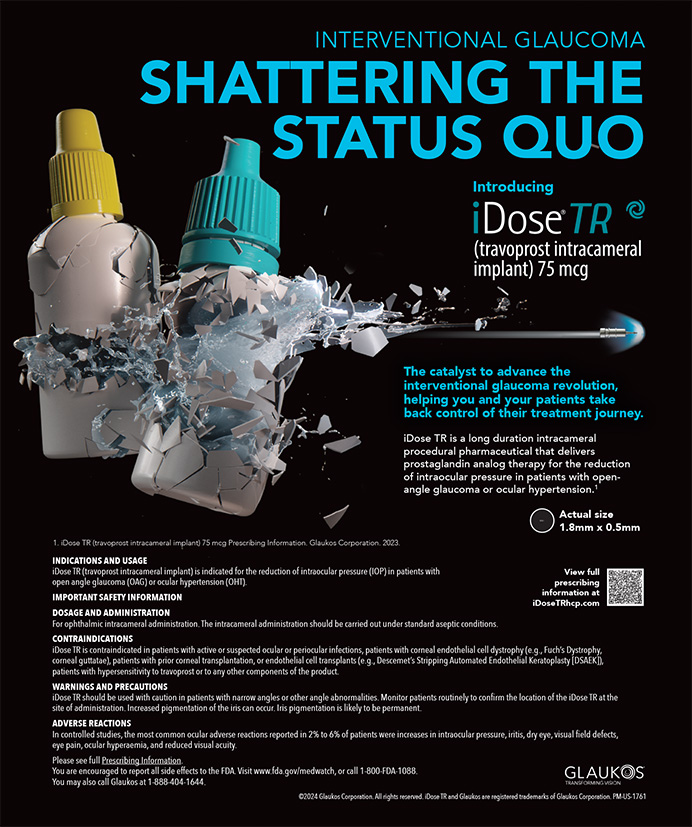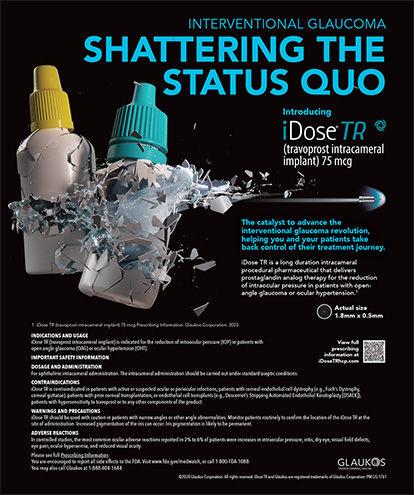Relative US rarities today, Morgagnian cataracts are hypermature with liquefied cortex. The mobile, dense nucleus inside the bag sinks within the lens milk when the patient is upright. As with intumescent cataracts, the lens capsule is under pressure. Comorbidities are common in these cases. Planning and a careful approach can surmount the challenges presented by these eyes.
PREOPERATIVE WORKUP AND PLANNING
The physician must assess the patient’s visual potential preoperatively by a swinging flashlight test in order to detect a relative afferent pupillary defect. Accurate light projection is important prognostically. A B-scan rules out a retinal detachment or a posterior segment tumor. An undilated slit-lamp examination to detect iris rubeosis or a compromised angle should precede surgery.
Asking the patient to monocularly fixate on a light will indicate whether topical anesthesia is practical. If the eye searches for the light, then a peribulbar block is appropriate. I recommend performing an immersion A-scan to calculate the IOL power.
Patients must be counseled about their elevated risk of complications and the potential for more than one surgery to achieve the best outcome. It is important that the clinician explain the possibility of transient or persistent binocular diplopia due to a long-standing loss of fusion.
Surgical planning includes an intravenous “push” (bolus administration) of mannitol 1/4 g/kg 15 minutes prior to the cataract procedure to reduce vitreous volume. I use a viscoadaptive agent (Healon 5; Abbott Medical Optics) and capsular dye, and I allow more time in the surgical schedule for these eyes.
SURGICAL APPROACH
The Capsulorhexis
In my opinion, a laser capsulotomy is risky in an eye with a Morgagnian cataract unless the surgeon first controls the chamber with an ophthalmic viscosurgical device (OVD), stains the capsule with trypan blue, and then docks the laser in a sterile manner. Otherwise, an incomplete flap will result, because turbid lens milk will block the laser beam from the moment the capsule is opened at any location. Even a 1.5-second laser capsulotomy is likely to be incomplete and produce confusing anatomy.
The initial surgical goal is to prevent the Argentinean flag sign, because at the slightest puncture, intralenticular pressure can cause the bag to split open in opposite directions. This dynamic tear can quickly progress around the equator and through the posterior capsule, clearly a bad start.
I begin by staining the capsule and making it as flat as possible and then controlling the chamber with a viscoadaptive OVD. A small curvilinear puncture with a cystotome on an OVD syringe allows the controlled egress of lens milk, decompressing the bag. Some surgeons prefer to use a 30-gauge needle bevel down on a tuberculin syringe to immediately withdraw lens milk on puncture. Intumescent lenses can have a high-pressure zone anterior and posterior to the nucleus, however, causing the aspiration technique to be less protective. I complete a small, controlled capsulorhexis while regrasping the flap often. Adding an OVD as needed improves visualization and keeps positive pressure in the anterior chamber relative to the posterior chamber. Upon completion of a continuous capsulorhexis, I/A removes escaped lens milk, and reinstillation of an OVD controls the chamber. The capsulorhexis can be enlarged if needed for safe margins that will not burst during phacoemulsification of the nucleus but will also remain small enough to allow optic capture of the implant as a backup plan.
Nucleofractis
Hydrodissection is unnecessary in these eyes; the nucleus is free-floating and no longer in the “vice” grip of cortex. I create a dispersive OVD sandwich to hold back the posterior capsule and protect the endothelium. Although some surgeons favor a supracapsular technique in this situation, my preference remains vertical cross-action chopping with circumferential disassembly of the nucleus within the confines of the bag.1 These nuclei tend to be large, and whether dark or tan, they are brunescent in character with leathery, interwoven fibers composing the posterior plate. Prolapsing the large nucleus forward requires a bigger-than-ideal capsulorhexis for the lens implant, and applying ultrasound to large, dense fragments near the endothelium can jeopardize rapid visual recovery.
I “lollipop” the nucleus. I disassemble it from the inside out with a blunt chopper (such as a Rosen Phaco Splitter) and avoid foot position 2 when not gripping nuclear material. As seen in the companion video, progress is slow but sure and requires no sculpting (Figure). My goal is to use ultrasound to gain purchase on lens material, while mechanical forces of the chopper fragment the nucleus and short bursts of phaco energy assist the aspiration of fragments. Rarely, in my experience, does even the most brunescent lens require more than 30 seconds of cumulative dispersive energy from the Infiniti Vision System (Alcon). Other phaco platforms can be similarly efficient with this technique.
I prefer burst mode and longitudinal ultrasound. I set fixed ultrasound power at an effective percentage for the given lens, often 80% to 90% for brunescence. The burst interval is linearly delivered rather than a set linear power. Because the technique depends on “holdability” more than “followability” or cutting ability, these settings—along with a Kelman-style, bent, 30-gauge phaco needle—are most efficient. Tight incisions help to maintain the chamber and reduce turbulence, while a soft shell of a dispersive OVD coats the corneal dome throughout the procedure. I step down the vacuum and flow rate to reduce surge when extracting the final fragments. Removing the chopper from the paracentesis improves followability and chamber maintenance during evacuation of the final fragment. Another option is to use a blunt instrument like a Rosen Phaco Splitter to maintain the capsule in a position away from the last fragment.
Fibrotic cortex sometimes hides in the capsular cul-de- sac. It is worth fishing for on I/A vacuum mode so as to leave a clean fornix and produce a quiet eye postoperatively. The posterior capsule can usually be polished clear, although a planned posterior capsulorhexis can be employed if there is fibrosis. Surgeons can implant their preferred lens in their usual manner.
CONCLUSION
The approach described herein allows patients with extreme vision loss owing to a Morgagnian cataract to immediately enjoy the miracle of vision afforded to more typical cataract patients.
Lisa Brothers Arbisser, MD, holds an emeritus position with Eye Surgeons Assoc., located in the Iowa and Illinois Quad Cities. Dr. Arbisser is also an adjunct associate professor at the John A. Moran Eye Center of the University of Utah in Salt Lake City. She is on the OptiMedica Surgeons Council, is a speaker for Abbott Medical Optics and Alcon, and has received honoraria for consulting from Bausch + Lomb. Dr. Arbisser may be reached at (563) 323- 2020; drlisa@arbisser.com.
- Arbisser L. Advanced phaco techniques for brunescent nuclei: cross-action chop circumferential disassembly. In: Chang D, ed. Phaco Chop and Advanced Phaco Techniques: Strategies for Complicated Cataracts. 2nd ed. Thorofare, NJ: Slack, Inc.; 2013:221-228.


